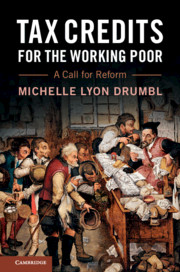Book contents
- Tax Credits for the Working Poor
- Tax Credits for the Working Poor
- Copyright page
- Dedication
- Contents
- Preface and Acknowledgments
- Abbreviations
- Introduction
- 1 A History of the EITC
- 2 Why the United States Uses Lump-Sum Delivery
- 3 How Inexpensive Administration Creates Expensive Challenges
- 4 Importing Ideas
- 5 Reimagining the Credit
- 6 Making a Case for Year-Round EITC Delivery
- 7 Protecting the Antipoverty Element
- 8 Beyond EITC Delivery and Administration
- Index
2 - Why the United States Uses Lump-Sum Delivery
Published online by Cambridge University Press: 24 July 2019
- Tax Credits for the Working Poor
- Tax Credits for the Working Poor
- Copyright page
- Dedication
- Contents
- Preface and Acknowledgments
- Abbreviations
- Introduction
- 1 A History of the EITC
- 2 Why the United States Uses Lump-Sum Delivery
- 3 How Inexpensive Administration Creates Expensive Challenges
- 4 Importing Ideas
- 5 Reimagining the Credit
- 6 Making a Case for Year-Round EITC Delivery
- 7 Protecting the Antipoverty Element
- 8 Beyond EITC Delivery and Administration
- Index
Summary
Chapter 2 examines how and why the United States chose to deliver the EITC in one annual payment as a tax refund, and how this is a stark contrast to how other social benefits are administered. One reason is administrative cost – it is relatively inexpensive to allow taxpayers to self-declare eligibility and receive benefits as a tax refund. Because other social benefit programs have direct contact with their recipients prior to payment, those programs have far higher administrative costs and far smaller overpayment rates. Delivery of social benefits through the tax system also avoids the stigma associated with applying for benefits through social welfare workers. This chapter cites empirical studies about taxpayer preferences as to delivery method and timing of refund and evidence as to how EITC recipients spend their refund. It also describes experiments with periodic payment, including the Advance Earned Income Tax Credit.
- Type
- Chapter
- Information
- Tax Credits for the Working PoorA Call for Reform, pp. 25 - 45Publisher: Cambridge University PressPrint publication year: 2019

